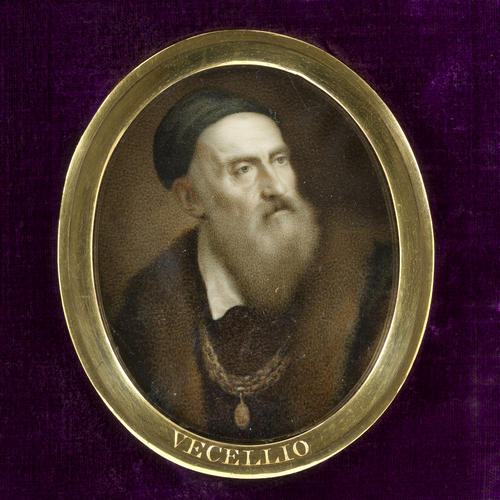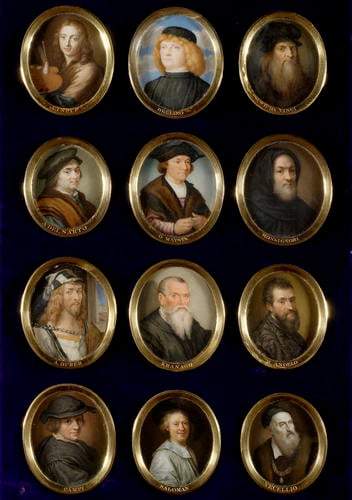Titian (1477/90-1576) c.1772-80
Watercolour on ivory | 6.2 x 4.9 cm (sight) (sight) | RCIN 421182
-
Titian (1477/90-1576), or Tiziano Vecellio, was born in Pieve di Cadore, a small town in the Dolomites from which his family supplied timber to Venice. When he was about 10 years old he was sent to Venice where he was probably a pupil of Gentile and Giovanni Bellini and collaborated with Giorgione on frescoes for the Fondaco dei Tedeschi (German trade centre) in Venice. He painted the Assumption for the church of the Frari when he was about 30 years old, which established his reputation as the leading young artist in the city. Titian painted a wide range of subjects, from altarpieces to mythological paintings and portraits, and his painting technique developed dramatically over his long career. Giorgio Vasari, the artist and biographer, wrote that his late works 'are executed with bold, sweeping strokes, and in patches of colour, with the result that they cannot be viewed from near by, but appear perfect at a distance …The method he used is judicious, beautiful, and astonishing, for it makes pictures appear alive and painted with great art, but it conceals the labour that has gone into them'. Titian worked for kings, emperors and popes, his talent promoted by his friend, the poet Pietro Aretino. In 1533, Emperor Charles V appointed him court painter and elevated him to the rank of count palatine and knight of the Golden Spur. However, he only visited Rome once, and Augsberg twice, preferring to remain in Venice. His success brought him great wealth and he lived in a large house in Venice with a garden overlooking the lagoon with a view towards Cadore, where he was born. He was recognised as a genius in his own time. Giovanni Paolo Lomazzo, the painter and writer, described him as 'the sun amidst small stars not only among the Italians but all the painters of the world'.
This miniature is one of the collection of copies of 224 self-portraits by artists in the Uffizi Palace, Florence, that Lord Cowper, the art collector and patron, commissioned Giuseppe Macpherson (1726-1780) to paint. He presented the miniatures to King George III in two batches, in 1773 and 1786. Macpherson followed the original self-portraits quite closely, but copied only the head and shoulders. He inscribed the artists' names on the backs of the miniatures – several differ from those in the modern Uffizi catalogue, notably: Bazzi, Bellini, Campi, Annibale Carracci, Gabbiani, Masaccio, Metsys, Moroni, Pencz, Licinio, Schiavone and Spada. None of the miniatures is signed, apart from Macpherson's own self-portrait, which is inscribed: Giuseppe Macpherson / Autore della serie (Giuseppe Macpherson / Author of the series).Macpherson was born in Florence, the son of Donald Macpherson, a footman in the service of Alexander, 2nd Duke of Gordon. He was a pupil of Pompeo Batoni and painted miniatures and enamel portraits in Italy, France and Germany, finally settling in Florence. A James Macpherson is recorded in London and Paris in 1754 but it is not certain that this is the same person. He was described in 1776 as having a special talent for painting on enamel and as being 'almost the only painter in Europe who possesses this art to perfection'. He had a distinguished client list which included some of the crowned heads and dignitaries of Europe. In 1778, he was invited to add his own self-portrait to the famous painters in the grand duke's collection as it 'would do honour to Florence to enrich the collection with a work which shows that we still have some men of true merit' according to Giuseppe Pelli, director of the Uffizi at the time.
Provenance
Presented to George III by Lord Cowper
-
Creator(s)
Acquirer(s)
-
Medium and techniques
Watercolour on ivory
Measurements
6.2 x 4.9 cm (sight) (sight)
Other number(s)
RL 01.1/12










